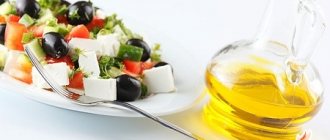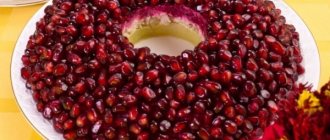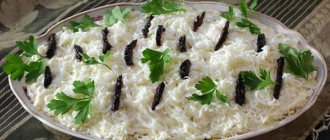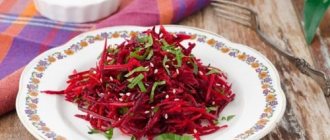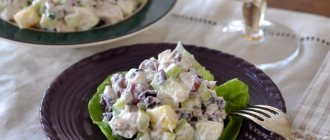Dill
A herbaceous plant belonging to the Umbelliferae family. It has a pleasant, attractive aroma and is rich in essential oils. Used in preparing cold and hot dishes, as well as in canning.
Dill intended for salad should have abundant greenery and remain fresh for a long time. The best varieties of dill to complement salad decoration are Amazon, Buyan, and Alligator.
Parsley
There are two types of parsley - curly and leafy. The varieties are completely different from each other in appearance, smell and taste.
Due to its ability to complement, transform or highlight the taste of any dish, it is very widely used in cooking.
In salads, it mainly acts as a seasoning, but there are recipes for cold dishes where this plant is the main ingredient.
Salads with parsley cleanse the body and promote weight loss. It is best to store this plant frozen, as most of the nutrients are lost during the drying process.
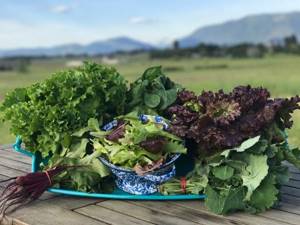
Green onions are annual shoots of onions. It’s rare that a salad can do without it. Its family includes many varieties used for making salads.
Leeks - the tender stalk of this onion successfully serves as a delicious addition to salads and enriches their taste.
Multi-tiered green onions have an unusual and fun look. There is an opinion that it is not able to accumulate nitrates. Its feathers are simply irreplaceable in preparing a variety of salads.
Chives are a very beautiful plant that tastes like green garlic. Its thin, bright green feathers appear in early spring, providing the body with vitamins. It grows densely and is widely used in cooking as salad greens.
Onion feathers can grow up to a meter. The whole plant is eaten, but mainly it is cultivated for its green shoots. Onions have a sharp and piquant taste and are very good fresh as a seasoning for dishes.
Slime onion is not only a vegetable crop, but is also often found growing wild. It has a mild onion taste and is used in preparing vegetable salads.
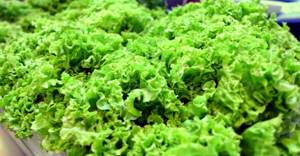
Let's diversify the taste of the dish with chicken and croutons
This recipe is no longer as dietary, its energy value will be higher, but the degree of saturation when consumed also increases. The dish is quite capable of replacing dinner or an afternoon snack and making you forget about the feeling of hunger for a long time. If you are not worried about every calorie, the chicken can be lightly fried or grilled.
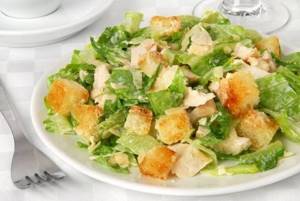
Compound:
- Lettuce - bunch
- White loaf - 100 g
- Chicken fillet - 1 pc.
- Salt - a pinch
- Olive oil - 1 tbsp.
- Ground paprika - 1/2 tsp.
- Sesame grains - 1 tsp.
- Lemon juice - 1 tbsp.
Preparation:
- Remove skin and bones from chicken fillet, rinse, place in salted boiling water, and boil for 45-50 minutes. over medium heat with the lid on. As soon as the fibers are easily separated from each other, the fillet should be removed, allowed to cool on a wire rack and cut into cubes or thin slices.
- Heat olive oil in a frying pan, pour in sesame seeds, fry for 1-2 minutes with the burner power slightly reduced, then crush the grains, add ground paprika, reduce the burner power to medium. Wait another 1-2 minutes.
- Heat the oven, scatter the diced wheat loaf on a baking sheet, coat each piece with the butter mixture and spices, and place the future croutons in the oven until browned. The approximate temperature is 100 degrees, periodically the crackers need to be turned over.
- In a large bowl, mix hand-torn lettuce leaves and pieces of boiled fillet, sprinkle with lemon juice and stir. Add the crackers last and mix all the ingredients. Serve on a flat platter. If desired, the salad can be decorated with sesame seeds.
Salad crops
There are more than a hundred types of green salad. The most popular of them are the following varieties:
- Romaine is a crisp, juicy salad crop. It is this variety that is used in the preparation of the famous Caesar salad; it has a nutty taste and delicate aroma, and is often used together with other salads.
- Rucolla - with thin stems and grayish-green leaves of an unusual shape, has a mustard taste and spicy aroma, goes well with cheeses, seafood and meat.
- Batavia - has a large rosette with green leaves, wavy along the edges, and is also brown in color. Crispy, with a sweetish taste, the salad is very popular in cooking.
- Lettuce - its most popular variety is Lolo Rosso. It is distinguished by a combination of green and burgundy colors, has a light nutty flavor, is rich in potassium, and is added to vegetable salads and meat dishes.
- Oakleaf is a type of head lettuce. It looks like oak leaves, has a very delicate and refined taste, goes well with mushrooms, smoked fish and avocado, and can be stored for no more than a day.
- Iceberg - resembles white cabbage. The salad has a slightly bitter taste and goes well with almost all foods. The leaves are often used as mini salad bowls, placing the dish directly on it.
- Watercress has a sharp, pungent taste that soon goes away, leaving a pleasant aftertaste, and successfully complements salad mixes.
- Korn is a field salad with small leaves, has a delicate aroma and spicy taste. It goes best with apples and walnuts and is suitable for many salads.
- Curly lettuces such as frisée, escarille and endive have a bitter taste and pair well with thyme, garlic and onion, and are often used in fish and cheese salads.
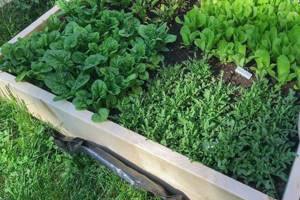
Salad greens also include wild garlic, celery, and Chinese cabbage. All divisions can be called conditional, because many types of plants are used both as greens and as main dishes.
For example, Chinese cabbage leaves are put in salads, but it is also stewed, stuffed and pickled.
Juicy stalks of petiole celery are used in making soups, pickled, dried and used as a spice.
Lettuce appetizer with pear and walnut
Apples most often appear in vegetable and meat salads, but pears are no less versatile in this regard. Choose an unsweetened variety of fruit, combine it with herbs, cheese and nuts, and you will get a hearty and tender dessert or even dinner. Of the leaf salads, spicy arugula goes best with pear.
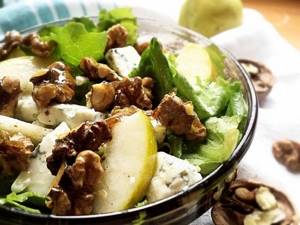
Compound:
- Arugula - bunch
- Large unsweetened pear - 1 pc.
- Blue cheese - 100 g
- Walnuts – 50 g
- White bread – 70 g
- Butter - 10 g
- Quail egg - 1 pc.
- Olive oil - 1 tbsp.
- Balsamic vinegar - 1 tbsp.
Preparation:
- Cut the bread into cubes, break the quail egg, separate the yolk, beat with softened butter. Dip the bread cubes into this mixture, but do not allow them to soak, and immediately distribute them onto a parchment-lined baking sheet. Place in a hot (100 degrees) oven until completely browned.
- Coarsely chop the cheese with a knife, cut the pear into thin slices, tear or chop the arugula leaves with a knife. Break the walnuts. Mix olive oil with balsamic vinegar.
- Place all the ingredients in a bowl, season with the resulting sauce, add the baked pieces of bread last, and stir. Serve on a flat platter, arranged on lettuce leaves.
Wild herbs
Another type of greens for salads are herbs that grow independently in nature and are usually found growing wild.
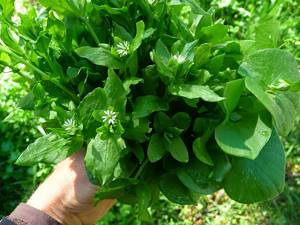
These include: nettle, gooseberry, shepherd's purse, buten, amaranth, sorrel, and burdock. The best time to eat wild herb salads is spring. All these plants can be consumed either as an independent dish or in combination with each other.
Preparing a healthy green salad
Green salad with champignons and walnuts
Ingredients:
200-250 g of frisee salad, the same amount of fresh champignons, a third of a glass of peeled walnuts, half a shallot onion, a couple of sprigs of tarragon, 3-4 tbsp. spoons of olive oil 1 teaspoon of walnut oil 2 tbsp. a spoonful of white wine vinegar and a little salt
How to prepare green salad with champignons:
- First, fry half of the walnuts, previously shelled, for 3-4 minutes over medium heat until a pronounced dark brown tint appears on them, then cool and cut into large pieces with a knife.
- In a deep salad bowl, chop the onion and tear the lettuce leaves, add salt, vinegar and tarragon, both oils and mix.
- Cut the champignons into small slices and place them on the surface of the salad. Serve immediately.
Salad of young cucumbers and zucchini. Watch the video!
Green salad with salmon
Ingredients:
100-150 g lightly salted salmon fillet a pack of salad greens 2 ripe tangerines half an onion 1 avocado a couple of tbsp. tablespoons balsamic vinegar the same amount of olive oil salt and pepper
How to prepare green salad with salmon:
- Fry the whole fish fillet in a frying pan in a small amount of oil, then cut the salmon into small cubes.
- Peel the tangerines, divide them into slices, remove the seeds, if any, then cut the citrus fruits into small pieces.
- Cut the onion into light feathers, and divide the avocado into two parts, remove the large seed from the fruit and also cut into cubes.
- Then place all these ingredients in a deep bowl, season with oil and balsamic vinegar, salt and pepper, and place fish pieces on top.
Baked pumpkin salad with arugula
from Alexander Seleznev. Watch the video!
Green salad with spinach and radishes
Ingredients:
400-500 g spinach 150-200 g radish 3-4 tbsp. tablespoons vegetable oil juice of 1 lemon 1 teaspoon mustard garlic clove salt and pepper
How to prepare green salad with spinach:
- Tear the spinach leaves into small pieces with your hands and quickly, before the leaves wilt even a little, add the sliced radishes to the greens.
- Separately, mix the ingredients for dressing the dish - oil, juice, mustard, garlic, salt and pepper, and very thoroughly.
- Season the salad with the sauce and serve it immediately.
Salad with greens and beets
Ingredients:
a bunch of fresh lettuce leaves 1 small beet 70-80 g peeled walnuts a bunch of finely chopped parsley 1 teaspoon walnut oil 1 tbsp. spoon of olive oil
How to prepare a salad with herbs and beets:
- First boil and peel the beets, then cut into small cubes and place in a salad bowl.
- Add salad leaves to the vegetables, which you can simply tear with your hands, chopped walnuts, chopped parsley and season the vitamin and nutritious dish with oil.
Spicy herbs for salads
They add sophistication to salads and enrich them with unusual flavors and aromas. However, you must be able to use them correctly, because even one extra leaf can change the taste of the dish, and instead of a piquant bitterness, give it excessive bitterness.
How to use correctly:
- take only in small quantities;
- do not subject to prolonged heat treatment;
- correctly combine with products;
- Do not use in combination with large quantities of other herbs.
The following is a list of the most common herbs used in cooking.
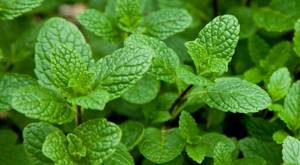
A well-known popular plant used in cooking in many countries around the world. Mint is used for salads, meat dishes and drinks. It does not tolerate heat treatment well, so it is consumed fresh. It has a pronounced cooling taste and delicate aroma. Goes well with almost all products.
How to eat green salad for its benefits

MOLDOVENII.MD
It has already been indisputably established that green salad stimulates metabolic processes and is an important product for nutrition, renewal and cleansing of the body.
The daily consumed amount of salad should be at least 150 grams, it should be eaten on an empty stomach, before each meal. The salad can be combined only with natural ingredients: cold-pressed olive oil, natural apple cider vinegar or freshly squeezed lemon juice, you can add just a little salt. Ideally, you should eat the salad a maximum of fifteen minutes after preparing it, otherwise its active ingredients are no longer as effective. Avoid eating foods that load your body with toxins, such as meat, fried foods, confectionery, or synthetic additives. They can be replaced with brown rice, pasta, oatmeal, wheat or corn flakes.
If you eat 500 grams of salad every day before meals and after desserts, this can significantly help in the fight against obesity. Weight loss is noticeable, which can be checked on the scale after just one week of such a diet.
There are, however, contraindications: abuse of any product, as always, can ruin everything. Experts have found that exceeding the doses indicated above, or eating salad for a long time without a break (from 2 weeks to 3 months) can cause dizziness and pain in the eyeballs. In such cases, there is no need to eat salad and resume the diet after at least two months.
Leaf lettuce helps in the fight against various pathological conditions. It has been found to activate certain metabolic processes and stimulate, refresh and cleanse the body.
Salad stimulates the appetite and helps restore the correct hemoglobin level index, thanks to the vitamins and minerals it contains. It fights various pathological conditions, including stress. Substances contained in green lettuce leaves stimulate and cleanse the liver, activate the intestinal tract, cleanse blood vessels and regulate the activity of the endocrine glands. Iodine salts prevent and fight rheumatism and atherosclerosis when used systematically. Magnesium salts are cell stimulants, they stop aging and help fight thyroid cancer, which is especially important for older people. Phosphorus salts play the role of plasticizers; in combination with vitamin D, they maintain optimal levels of calcium in the body. Zinc salts contained in lettuce leaves have a beneficial effect on the formation of red blood cells, on the functioning of the gonads, pituitary gland and pancreas. Chlorophyll contained in lettuce leaves helps prevent anemia, and amino acids contained in large quantities play an important role in normalizing digestion and helping with constipation. In addition, lettuce helps in maintaining the integrity of the skin and treating many skin diseases.
Source: agriculturae.ro
Cilantro
Cilantro (coriander) can be used both as a spice and as a vegetable. Its young fragrant leaves are similar to parsley, but have a stronger aroma and a slight bitter taste.
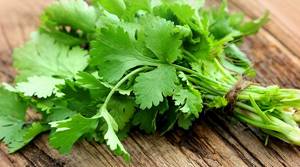
It is used as fresh herbs for salads and soups, and dried as a spice for meat dishes. Green cilantro leaves help the body digest heavy foods. It is no coincidence that this aromatic greenery is so popular in the Caucasus, where it is consumed together with meat.
What to add to the salad
A fresh salad can be made even healthier and tastier by adding a few ingredients such as chopped nuts, sunflower or pumpkin seeds, fresh pomegranate seeds, ground flaxseed, oat bran, fresh sprouts and sprouts, and hard cheese. For a heavier version of a fresh salad , add croutons (croutons, croutons) or finely chopped fried (grilled) bacon.
Don't overdo it with additives! After all, we make fresh green vegetable salad . It is better to limit yourself to one or two additional components. Crumbs (see recipe below) and beautifully thinly “shaved” Italian hard cheese (Parmesan or Pecorino) are traditional additions that are placed on top of the finished fresh salad before serving.
Basil
The greens of this plant are popular in many countries of the world. Young fresh basil leaves are added to salads, hot dishes, drinks, sandwich mixes and sauces.
Several varieties of this plant are known:
- Yerevan - the most famous and widespread, has the usual spicy taste, has a peppery smell, and purple leaves.
- Anise Delight - with dark green leaves and a distinctive anise scent.
- Clove - has a specific clove smell that can overshadow the clove itself.
- Lemon - has a fresh lemon smell, gives salads an original taste with a slight sourness.
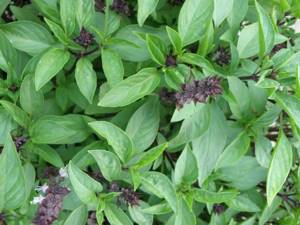
In fact, there are even more varieties of basil. But not all varieties are suitable for making salads. Many species have found their use only as a seasoning for hot dishes, or for flavoring baked goods.
With raspberries and feta cheese
Do you want something unusual, with a sweet note? Try the raspberry and feta salad. Pine nuts will add piquancy, and the dressing will be lime juice and honey.
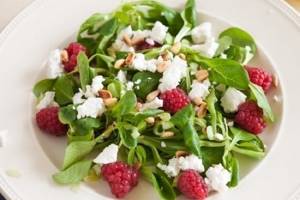
Compound:
- Leaf lettuce (small) - bunch
- Fresh raspberries – 250 g
- Peeled pine nuts - 50 g
- Feta cheese - 120 g
- Lime juice - 2 tbsp.
- Liquid honey - 1 tbsp.
Preparation:
- Tear the lettuce leaves from the bunch, crumble the feta cheese by hand, heat the pine nuts in a dry frying pan for 1-2 minutes.
- Heat the honey in a water bath, add lime juice to it, stir the dressing and cool slightly.
- In a common salad bowl, combine all ingredients except raspberries, season with honey-lime sauce, and stir. Place on a common dish, add raspberries.
Oregano
Popularly known as oregano. She can add intriguing notes to any fornication. Pairs especially well with chicken, vegetables and cheese. It is considered a distant relative of marjoram, only piquant and richer, with a tart aftertaste.
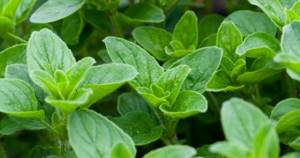
There are several types of oregano. And each complements the dish in its own way. Does not combine with other herbs except thyme, basil and pepper.
Oregano is very good in salads, especially with mushrooms, olives, tomatoes and capers. It is believed that it improves tone and improves mood.
Quick salads with lettuce: recipes with photos
The attractiveness of the dishes discussed below lies in the fact that their components do not need to be thermally processed: this often saves a lot of time and allows you to get a traditional fresh version of the dish that is completely harmless to your figure. The calorie content of all these salads is unlikely to exceed the level of 70 kcal per 100 g, which means you can enjoy them without fear. If you are watching your weight, but want something nutritious and tasty, prepare a salad of lettuce with olives, mozzarella and bell peppers.
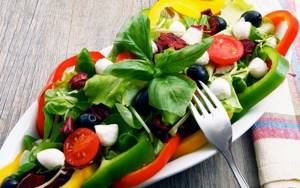
Compound:
- Leaf lettuce (various) - 2 bunches
- Pitted olives - 200 g
- Cherry tomatoes - 10 pcs.
- Bell peppers (preferably different colors) - 2 pcs.
- Mozzarella – 150 g
- Olive oil - 1 tbsp.
- Basil - sprig
Preparation:
- Cut bell peppers into half rings, tomatoes into halves, leave olives whole or halve them. Tear lettuce leaves with your hands, do not deform small ones.
- Place lettuce leaves in a salad bowl, place half rings of pepper on the sides, distribute tomatoes and olives inside, add mozzarella, season with olive oil, fluff lightly with a fork. Before serving, garnish with basil leaves.
Marjoram
The herb has both a sweet and pungent taste and a persistent camphor aroma. Reminds me of a mixture of mint, oregano and black pepper. Thanks to such a complex smell, the plant can enhance any dish.
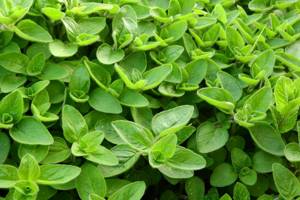
A pinch of fresh marjoram will enhance any salad, especially if it contains potatoes, mushrooms, meat, poultry, eggplant or zucchini.
The spice goes well with oregano, cumin, basil, and thyme. The herb is successfully used in salt-free diets to tone down the blandness of dishes.
Salad with shrimp and quail eggs
Lettuce leaves definitely go well with any ingredient - they “sound” no worse with seafood than with the usual poultry or veal. If you don't want to bother with boiling and peeling the shrimp, you can replace them with krill meat, sold in small tins. There is no need to fry it - you can add it immediately after opening the container.
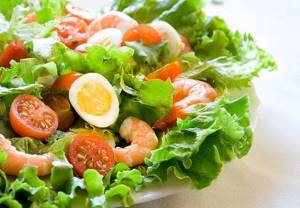
Compound:
- Lettuce - bunch
- Shrimp – 300 g
- Cherry tomatoes - 6-7 pcs.
- Quail eggs - 3 pcs.
- Ground cucumber - 2 pcs.
- Soy sauce - 1 tsp.
- Olive oil - 2 tbsp.
- Dried basil - a pinch
Preparation:
- Boil the quail eggs so that the yolk is barely set, transfer to cold water, and leave for 1-2 minutes. Peel, cut in half.
- Boil shrimp in boiling water for 5-7 minutes, peel and add salt. Heat 1 tbsp in a frying pan. olive oil, fry the shrimp in it until golden brown.
- Combine the remaining olive oil with soy sauce, add dried basil, lightly beat the mixture with a fork.
- Place half of the whole lettuce leaves on a flat plate. Tear the rest into large pieces with your hands, throw into a common bowl, and top with half-circles of cucumbers and cherry tomato halves. Add the shrimp last and fluff all the ingredients with a fork.
- Season the resulting salad with soy-oil mixture, leave for 3-5 minutes, transfer to a flat dish, garnish with quail egg halves. Serve to the table.
How to choose the right herbs and greens
In order not to make a mistake with the choice of herbs and herbs, you need to know them by sight. You should not take plants that have dried out or, on the contrary, too wet places. This indicates that the grass was picked a long time ago and was stored in water.
To determine the freshness of a plant, rub one of its leaves with your finger. When picked recently, it can not only stain your finger with its juice, but also spread its smell over a distance.

The smell of greenery picked long ago can only be felt by bringing your fingers directly to your nose.
The best solution is to grow greens and herbs yourself in the garden, on the balcony or windowsill.
The variety of salad recipes is amazing. But the most useful are those that were prepared only from natural plant foods. The beneficial effects of greens on the human body have been known for a long time, so it is recommended to include it in your diet every day. It is rich in vitamins, chlorophyll and vegetable protein.
To diversify your kitchen, we suggest you familiarize yourself with the types of greens for salads.
Types of greens for preparing salads
Deciduous
Very rich in vitamins and organically processed basic salts. It is richer in iron than all other nutrients. Chlorophyll, the substance that gives leaves their green color, has a very beneficial effect on the human body: it increases metabolism, tones and rejuvenates. In addition, green leaves contain complete proteins.
Salad
Of the vitamins, it contains especially a lot of A. Properties depend on the variety and the time of year. The richest mineral composition is provided by the romaine variety, but in the fall this lettuce loses some of its properties, and lettuce loses them by the end of summer. There is, however, good winter romaine. Lettuce is a delicate salad. Preference is best given to the head varieties of lettuce. Romaine is strong and soft, escarole and endive are firm: these are late varieties. The salad is well preserved even in hot weather if it is placed with the roots down in a bowl of water (a bouquet of lettuce).
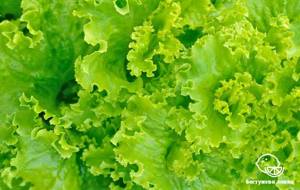
Sorrel
Of the cultivated varieties, the best is French. Only young sorrel is suitable for a raw food diet. With constant pruning, it can produce a suitable product all summer, but the best sorrel is spring sorrel. Its action is blood purifying and tonic. Its stems are also used.
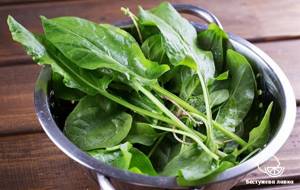
Spinach
The French variety is more tender than the German one, and is more suitable for raw vegetable dishes; it is much lighter and smaller than the German one. The richest vegetable in organic salts, it contains all vitamins, especially A. It also contains a lot of potassium and iron.

Chicory salad
Cultivated in many peasant gardens in the Leningrad region. Leaves should be trimmed when they reach 10 cm in length. It tastes like dandelion leaves.
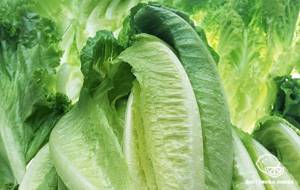
Cress
The best variety has dark green bright leaves (bruncress). Very rich in iron. It’s a pity that this variety is almost never grown in Russia. Watercress with very small light leaves is known for its antiscorbutic properties and is excellent for growing indoors, even in winter.
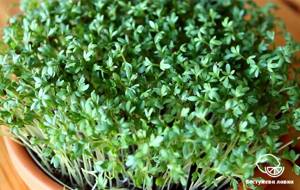
Celery
One of the most valuable plants for a healthy kitchen, thanks to its diuretic, antitoxic and tonic properties. Leaf celery is especially flavorful. As a rule, its leaves and stems are eaten. If you use only the outer parts of the plant, cutting them off as needed, then the same plants can last a long time. We recommend that you read the article “Re-growing vegetables at home.”
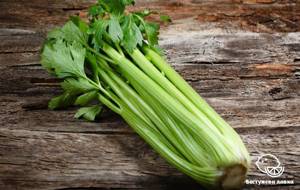
Beet tops, radish tops, radish tops
It is consumed when it is young, very fresh and juicy. Carrot tops, when fermented, give a good product.
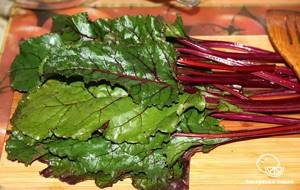
Leek
Has beneficial properties. Grown almost all year round. It can also be cultivated in pots, cutting off the leaves and stem as it grows. The best varieties are large. A healthy kitchen goes with the inside parts.
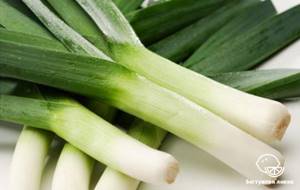
Green garlic and onion
Garlic greens are used only when they are young (fresh).
The best onions are short and thick; the tips of the leaves should be trimmed (they wither quickly).
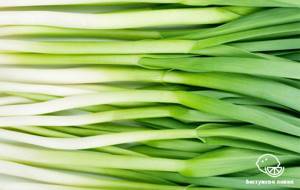
Rhubarb
The leaves are not suitable for eating. They need to be trimmed carefully. The organic acid contained in the raw stems does not seem to cause the same harm as when it is converted to inorganic acid by cooking. It is good to store the stems by immersing them in a bowl of cold water.
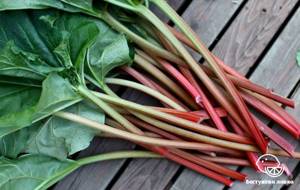
Asparagus
Contains vitamin C, significant amounts of calcium and sulfur. Adherents of a healthy diet consume it when the stems reach at least 15 cm in length, finding a particularly good taste in it.
As a rule, vegetable stems do not contain as many useful elements: vitamins, salts, etc., as leaves, and vegetables grown without light (white vegetables) are poorer in useful composition than others.
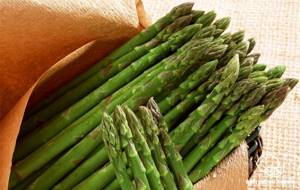
How to store greens at home
Keep in a cool, ventilated area or on a cooler, in small quantities, tightly wrapped in paper or with roots submerged in water like a bouquet. If you want to extend the shelf life even further, then in baskets covered with paper, having first cleared them of root leaves, rot, and flaccid parts. It should be placed with the roots facing up.
The article presents a small portion of greens that are suitable for preparing salads and other healthy dishes. Fortunately, nature has given us a large amount of plant food.
What greens do you like to add to salads?
If you find an error, please select a piece of text and press Ctrl+Enter.
In one form or another, greens are present in the diet of any person. It can be a seasoning and addition to food or a main dish. Only quantity determines whether a culture will be a spice or a full-fledged dish.
Delicious green salad
Tweet
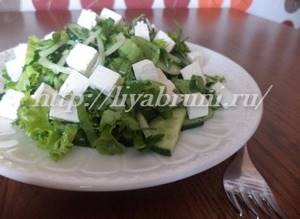
In fact, this is not a salad, but a holiday! A holiday for those who do not eat meat, do not like fish, and refuse pasta in the name of a figure. But seriously, a very tasty and nutritious recipe, there won’t be any left for tomorrow!
It will take you literally 25 minutes to prepare a delicious green salad The grams below are for 4 servings. The total volume of the salad contains only 103 Kcal. I spotted this recipe on the pages of A.G. Krasichkova’s cookbook. “Great Salads” and thanks to its spring freshness easily took root in my kitchen and became a frequent guest on the table.
We will need:
- 1 bunch of green salad
- 1 bunch of sorrel
- 2 cucumbers
- 0.5 bunch of green cilantro (replace with parsley in the recipe, due to personal taste preferences)
- 150 g cheese
- 1 onion
- 2 tablespoons olive oil
- ground red and black pepper
- salt
- vinegar
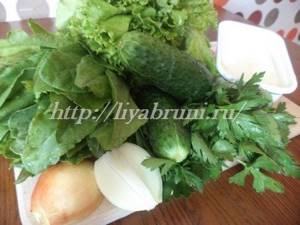
Preparation:
- Collect our delicious green salad I advise you to start with vitamins B1 and B9, beta-carotene, ascorbic acid, vitamins E and PP, C - did I confuse you? It’s simple - lettuce and sorrel leaves are rich in these vitamins, we will wash them, dry them, and chop them coarsely.
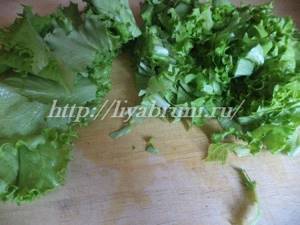
- Wash the parsley (cilantro) and chop it. Now our salad has vitamin K, which helps the body absorb calcium and normalizes blood clotting.
- And now let’s get down to everyone’s favorite spring delicacy, which beckons with its fresh aroma and perfectly satisfies hunger - cucumbers. They need to be washed and cut into semicircles.
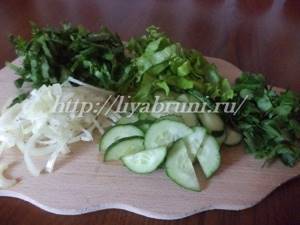
- Onions are the undisputed leader in all culinary recipes! I ask you to be careful in dosages with it, because it increases appetite and at the same time speeds up the digestion of food. The onion needs to be peeled, washed, and cut into half rings. Advice from the performer: it is preferable to marinate the onion for 5-10 minutes, sprinkling a little wine vinegar and seasoning with black pepper.
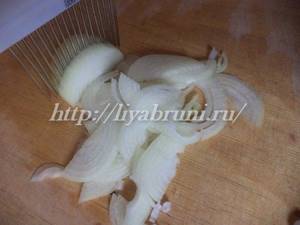
- Cut the cheese into cubes. In an amount of 150g, it will add 1.5 daily calcium requirements for one person to our salad.
- Mix lettuce, sorrel, cucumbers, cheese, onion and cilantro. Season the salad with salt and pepper, season with olive oil, mix, arrange on plates and serve.
Bon appetit!
Want more Recipes that are not on the blog? I offer you my collection of Healthy and Dietary Eating Recipes! A collection of recipes that include main courses, desserts and sugar-free baked goods, as well as dietary and natural sauces. Access to the collection along with a bonus here:
On the site you will find other useful culinary recipes for body and soul, so subscribe to the site’s daily newsletter “Live with Pleasure!”
What is considered green?
Anything that is collected or grown to produce the above-ground leafy part of a plant is classified as greens. Moreover, color is not a determining factor at all. Much-loved basil tastes best when it is dark purple in color, and green peppers or green beans are definitely not herbaceous plants.
Spices include fresh or dried herbs that are used to improve the appearance, taste and digestibility of dishes. Many seasonings are used as aphrodisiacs or sources of vitamins. Infusions and decoctions of herbs (mint, oregano, thyme) are used to treat digestive disorders and respiratory diseases.
Types of greens to eat
There are many classifications of herbaceous plants used for food. Based on their origin, they distinguish between cultivated and wild. The most common cultivated vitamin trinity: dill, parsley and green onions.
Dill
An annual herbaceous plant belonging to the Apiaceae family. It has a pleasant aroma and contains a large amount of essential oils. Used fresh and dried. Used for dressing salads, first and second courses, as well as for adding to marinades and pickling. Dill inflorescences and seeds are often used as seasoning. It is impossible to imagine a garden without this plant. It is grown under film covers, in greenhouses and in open ground. It can also spread by self-sowing.
Salad and spinach greens
Edible greens are distinguished by the method of consumption. In addition to the described cultivated green crops, this group includes all salads. They contain a lot of plant fiber, which helps improve intestinal function, vitamins and minerals.
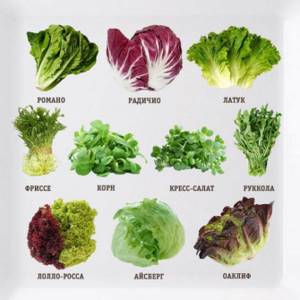
Lettuce comes in many shapes and colors.
- Romaine is a bright green lettuce. Contains vitamins, mineral salts and is used fresh for making salads.
- Radicchio is a salad chicory with an original color and pleasant taste. Use both fresh and after heat treatment.
- Lettuce is a vegetable familiar to our table. The leaves are added to spring salads with radishes and dill. But an almost forgotten childhood treat is the tender center of the salad with sugar.
- Frisse is a bitter salad. In terms of vitamin C content it can compete with lemon. Add to salads and use for snacks.
- Corn contains a lot of folic acid, vitamins, and microelements. Healthy and tasty. Sold as part of salad mixes. It can also be grown on a personal plot.
- Watercress has a sharp, burning taste, but it goes away quickly, leaving a pleasant aftertaste. It grows on site without any hassle and can spread by self-seeding.
- Arugula tastes a little like watercress. Beautiful cut leaves look good in salad and give it a pleasant bitterness. Unpretentious when growing.
- Lollo Rossa is similar in taste to lettuce. Its young green leaves are collected in small heads of cabbage. As they ripen, they acquire a reddish-cherry hue. Like lettuce, it grows well in the area. Used in salads, put in sandwiches.
- Iceberg is a head of lettuce with crisp, tender leaves. It contains useful vitamins and organic acids. The slugs in the area quickly find it.
- Oakleaf is another variety of head lettuce. A very delicate crop, it is poorly stored, but it is easy to grow even at home. The leaves are shaped like oak leaves.
Swiss salad
Ingredients
- Lemon - 1 pc.
- Arugula – 50 g
- Leaf lettuce - 50 g
- Iceberg salad – 50 g
- Walnuts - 100 g
- Wheat crackers - 50 g
- Olives (pitted) - 200 g
- Crimean blue onion - 2 pcs.
- Olive oil - to taste
- A mixture of herbs - to taste
- Salt - to taste
- Sugar - to taste
Cooking method
Squeeze the juice from the lemon, add salt and herbs to it.
Cut the onion into cubes and add lemon juice. Leave for 10-15 minutes.
Tear the lettuce leaves into large pieces, add onions, pieces of nuts, olives, pour the marinade and olive oil over the salad and sprinkle with croutons.
Spices
These are green plants that are used only as a seasoning. All herbs have some medicinal properties. There are many of them, we will list only the main ones.
- Oregano, or oregano, is an aromatic perennial. It occurs wild and grows in patches. In Western European cuisine, it is added to salads and sauces, and seasoned with meat dishes. And Italians use oregano in making pizza. In our country, dried oregano herb is brewed into tea. In medicine, it is used as part of chest preparations.
- Hyssop is a perennial herbaceous plant with beautiful flowers and a sharp, pleasant aroma. Used in marinades and pickles. Add to salads if desired.
- There are different types of mint: peppermint, lemon mint. But any one decorates the garden and can grow so large that you have to save yourself from it using radical methods. At the same time, it has a unique taste and aroma, and is indispensable in cocktails. Tea with mint is an invariable attribute of country gatherings. Dried mint is used when marinating meat for barbecue.
- Lovage is a perennial shrub with a pungent but pleasant aroma. A lovage leaf added to the pickling will make its taste unforgettable.
- Thyme, or thyme, is a very decorative perennial. It is grown as a perennial garden crop and is found in the wild. Dried twigs and leaves of thyme have a mild expectorant effect. Delicious in tea mixtures. Used as a seasoning when cooking steaks. Chef Ramsay often recommends fresh thyme.
- Savory is an annual spicy herb with a pungent smell and taste. Pairs perfectly with meat dishes. It is similar to thyme only in name. The aroma, taste and appearance of these plants are different.
- Tarragon, or tarragon, is a perennial crop. When eating fresh tarragon herb, the oral cavity is pleasantly cooled. Because of this property, tarragon extract is added to a refreshing drink. Used as a seasoning for fish dishes. Dried herbs are added to soups.
When growing on site, you need to choose fertilized soil for tarragon and replant it every two to three years, otherwise the greens will stretch out, run wild and lose their aroma.
Dressing (sauce) for salad
You can serve a fresh vegetable salad already dressed, or you can leave the decision of what and how to dress the salad to the discretion of each participant in the meal. Set the table with the best quality vegetable oil you can afford, along with good natural vinegar and homemade salad dressing or sauce. You don’t have to limit yourself to olive oil, which is so popular now; there are other excellent vegetable oils: peanut, grape seed, rapeseed, hemp, walnut and others. For fresh consumption, always choose cold-pressed oil. The price of vegetable oil usually adequately reflects its quality, because producing oil from fresh raw materials is a rather expensive process.
Delicate leaf salads (so-called oil salads) require more delicate dressings (for example, French
), while denser ones (romaine lettuce, batavia, endives) go well with both French and heavier dressings (
Caesar
,
blue cheese
or
ranch
).
It is better not to use shelf-stable dressings from the store (those sold on grocery shelves at room temperature) - they contain high amounts of salt, sugar, starch, preservatives and flavor enhancers. Much better quality dressing can be found in the deli section of a good grocery store (it's fresh, requires refrigeration, and is only good for a few days), although these dressings are often expensive. The best option is to make your own simple homemade dressing that is tasty and healthy. It only takes a few minutes.

